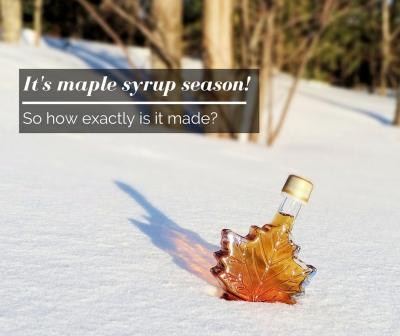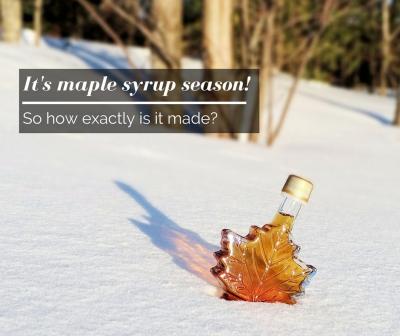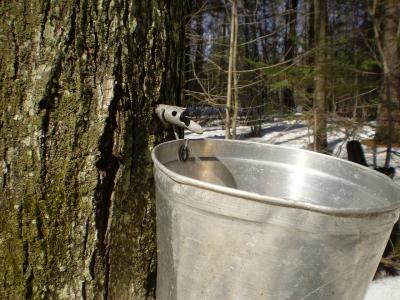Maple syrup is made from the sap of — you guessed it — maple trees. But while many people picture maple sap to be of similar texture to maple syrup, it’s actually much thinner. Traditionally, the syrup is made by drilling a hole into the bark of a maple tree and inserting a tube, out of which the water-like maple sap flows and is collected with buckets. Of course, now the process involves long plastic tubing in order to collect the sap in much larger containers and a centralized location. Once collected, the thin sap is evaporated using heat, in order to concentrate the sugars and produce the thicker, stickier texture that we’ve come to know and love.
The maple syrup season is rather short, typically lasting around 4-6 weeks and starting from as early as February to late April. Essentially, sap is the liquid starch that the maple tree as stored in order to use as food. During the transition from winter to summer, the changes in temperature and length of day—basically as the days begin to warm up but the nights remain cold—act as a signal to the tree that it is time to start sending the sap up to the tree’s branches so it can begin replenishing itself. Since it will still get rather cold at night, the tree sends the sap back down for storage in order to prevent it from freezing in the branches. It is this flow of sap, following the changes in temperature, that allows us to tap the sugary liquid for our own purposes.
Indigenous peoples are believed to be the first to collect and use maple syrup, followed by Europeans settlers who learned of the strategy when they arrived to the new world, and eventually refined the production method. Today, the Canadian province of Quebec is the world’s largest producer of maple syrup, responsible for approximately 77 percent global supply. In the United States, Vermont leads as the biggest producer, responsible for about 5.5 percent of the world’s maple syrup.
Indigenous peoples are believed to be the first to collect and use maple syrup, followed by Europeans settlers who learned of the strategy when they arrived to the new world, and eventually refined the production method. Today, the Canadian province of Quebec is the world’s largest producer of maple syrup, responsible for approximately 77 percent global supply. In the United States, Vermont leads as the biggest producer, responsible for about 5.5 percent of the world’s maple syrup.
There are some health benefits to consuming maple syrup over other forms of sugar: it’s lower than cane sugar on the glycemic index, is full of antioxidants, fights inflammatory diseases, protects skin health, supplies vitamins and minerals, calms your stomach, and can boost your immune system. However, sugar is still sugar, so it’s important to remember to consume it only in reasonable quantities.
The tapping of maple trees in the spring has become a tradition, and there are often events where people can go and witness the process for themselves. So as the end of the season approaches, I encourage you to go out and see some maple trees being tapped in your area! And of course while you’re at it, pick up a bottle of the good stuff.
The tapping of maple trees in the spring has become a tradition, and there are often events where people can go and witness the process for themselves. So as the end of the season approaches, I encourage you to go out and see some maple trees being tapped in your area! And of course while you’re at it, pick up a bottle of the good stuff.








